Review: 3D printers in military service

The military industry has always been at the forefront of progress: many inventions either began their life journey as products of military or dual use, or, in the first years after their appearance, were involved in this area. In this age of digital technology, this fate and 3D printing have not passed .
3D printers are actively used by military contractors and directly employees of all branches of the military.
Table of contents:
In Russia
In the world
- Aviation
- Fleet
- Ammunition and small arms
- Uniform and protection
- Construction
- Self
- maintenance - Electronics
Concepts
Conclusion
In Russia
JSC Federal Research and Production Center Titan Barricades, which develops missile systems and military vehicles, has bought and used in prototyping a set based on the XJRP SPS450B 3D printer . The kit consists of two devices: a 3D printer directly with a large print area, working on SLA technology, and a polymer curing chamber.
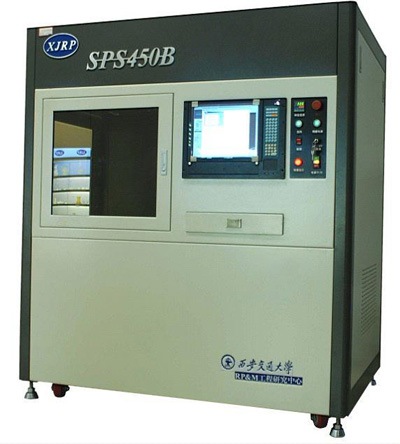
3D prototyping kit XJRP SPS450B.
Source: pechat3d.ru A
3D printer is planned to be used to create miniatures of future parts, housings or assemblies of mechanisms. The first product made on this 3D printer was a prototype wheel with a tread.
Ilyushin’s specialists plan to produce some simple parts for the Il-112B military transport aircraft using the 3D printing method.
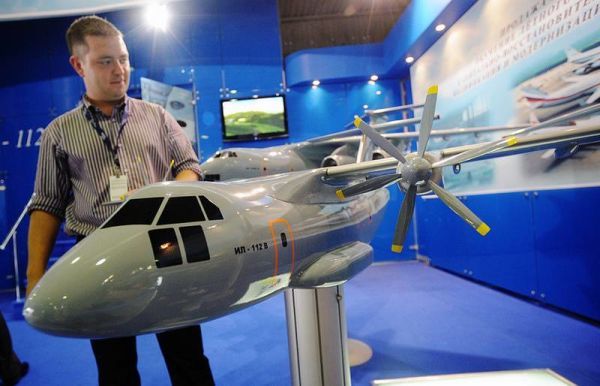
Model of IL-112V transport aircraft.
Source: ITAR-TASS
Together with specialists from the Voronezh Aviation Plant (VASO), PJSC “Il” specialists use parts printed on a 3D printer as test samples that will be replaced with originals made by the classical method before departure. But in the future it is planned to master the printing of simple components that will be installed on mass-produced aircraft.
According to Pavel Chernikov, First Deputy Director General of PJSC “Il”: “The Il-112B is created from scratch, and many parts and components, during installation on the aircraft, require revision. We began to use a 3D printer to understand how correct or incorrect our calculations were. Such technologies allow not to be interrupted for the finalization of finished products, which, in turn, significantly reduces the time of installation of equipment and reduces the cost of production. ”
JSC “Scientific and Production Corporation“ Uralvagonzavod ”named after F.E. Dzerzhinsky” purchased a S-Max 3D printer , manufactured by ExOne.

Source: 3dtoday.ru
This printer is intended for the manufacture of sand forms. Forms are used for casting metal blanks. As the deputy chief metallurgist NPK “Uralvagonzavod” said: “We no longer have to make expensive casting equipment for experienced, new products and complex small series castings. It will be enough for the designer to develop a 3D model of the required casting, according to which, also in 3D, the form will be designed and manufactured. Finished rods will go to the foundry. In addition, to solve the problems of the corporation, they can be transported over any distance. ”
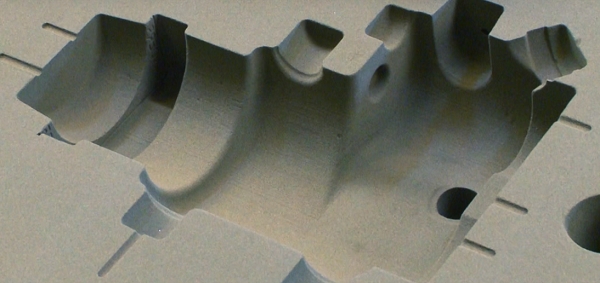
Source: 3dtoday.ru
This is not the first professional 3D printing system that Uralvagonzavod uses. In 2015, the company purchased a Fortus 400mc 3D printer manufactured by Stratasys Corporation. This printer is used in the manufacture of parts for the T-14 Armata tank and other machines manufactured by Uralvagonzavod.
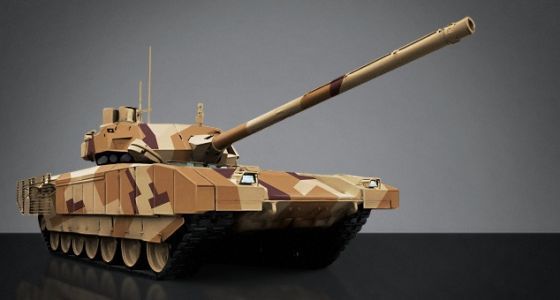
Tank T-14 ("Object 148") on the platform "Armata".
Source: OAO NPK Uralvagonzavod.
Representatives of the company note that the introduction of 3D printing saves time and production resources. It is not required to expend forces on the recess of metal samples. If the part does not fit, it is easier to reprint it than to grind again.
The holding company “Helicopters of Russia”, according to its CEO Andrei Boginsky, plans to print on the 3D printer about a hundred parts for helicopters by 2020.

Andrei Boginsky
Source: Yuri Smithyuk / TASS
In 2018-2019, it is planned to conduct a series of bench tests in order to obtain all the necessary certificates for printed parts by mid-2020. In total it is planned to test about a hundred parts and assemblies.
Compared to traditional ones, parts printed on a 3D printer have less weight and their production will be deployed at the Kazan Helicopter Plant. As a result of the use of parts obtained by 3D printing, the holding plans to reduce the cost of products.
In the world
The road of the army 3D printing is not paved with roses. When we hear about awesome army projects made using 3D printing, we need to take into account some of the problems that arise when doing them.

Military personnel get acquainted with FORTUS .
Source: all3dp.com
The problem of quality certification. Many things that the army is supposed to produce using 3D printing are designed for harsh operating conditions, they are subject to high requirements for respecting dimensions, geometry and quality, and an unsuccessful printed part can lead not only to monetary losses, but also to the death of soldiers . This issue will most likely be solved by certification of the 3D printers themselves.
Insufficient print speed for the army. Even the most expensive of 3D printers is not fast enough. There are also problems of secrecy / security, copyright, and many other details that are not obvious at first glance.
While these problems are being solved, the US Navy Department decided to conduct a hackathon on 3D printing. 12 organizations that showed their developments in the field of 3D printing for the Navy were involved. According to the participants, fully or partially printed inventions: “Allow to improve the ability to maintain combat readiness.”
One of the new and memorable developments was the four-legged conveyor robot (MeRlin). It turned out quite compact and can run, jump and walk the stairs. Three-dimensional printing made it possible to create a hydraulic manifold, directly in the supporting frame of the robot, that serves to transfer energy to the drives of the robot. Those interested in robotics will find a similarity to the transport robots of Boston Dynamics in “Merlin”.

The device of the robot “Merlin”.
Source: all3dp.com
Aviation
From the side of one of the British Royal Navy ships in the sea, HMS Mersey, a drone was made using 3D printing technology. The device was created in collaboration with the University of Southampton.
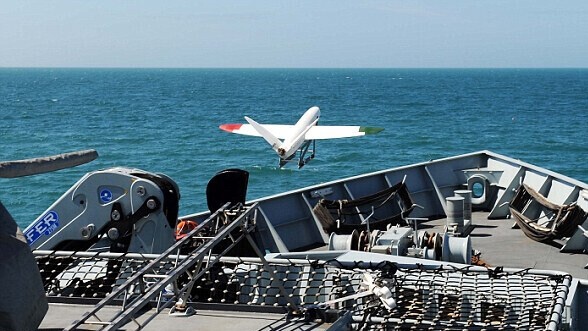
Launching a drone printed on an EOS 3D printer .
Source: all3dp.com
The case is made of nylon, using laser sintering technology. With a wingspan of one and a half meters, the drone weighs only three kilograms. The main task that was set in front of this project was the creation of a small UAV for the study of the surroundings, which can be quickly printed on board the ship.
On the drone, called SULSA, was installed a small video camera. Management was conducted by researchers from Southhemton with the help of video cameras. The flight, with a range of 500 meters, lasted only a few minutes, but proved that 3D-printed drones can be launched from the sea.

Route drone SULSA during a test flight.
Source: southampton.ac.uk
3D printing solves the problem of the limited capacity of ships, allowing equipment to be printed at sea as needed. The only thing you need to have on board to print a drone is a 3D printer and a nylon supply, which is incomparably cheaper than a case made using traditional technologies and takes up much less space.
The only drawback is the speed of printing, but it is expected that it will increase in the near future. Engineers from the American Army Research Laboratory (ARL) are trying to fight this shortcoming. They are developing drones that can be made within a day. Engineers create drones that can be used to help soldiers: for communication, delivery, and observation from the air.

Eric Sopero, demonstrates his drone to the US military.
Source: all3dp.com
Drones are made using ready-made engines and propellers, but their body is almost completely printed on a 3D printer. The maximum speed of the drone is 55 miles per hour. Drones can both be controlled by the operator from the console, and work in a fully autonomous mode. Work continues on reducing noise and increasing flight range, maneuverability and carrying capacity.
The US Army is collaborating with the Marine Corps in compiling a catalog of spare parts for unmanned vehicles that can be loaded onto an employee tablet. The software of this catalog allows you to order or carry out 3D printing of the product directly from it.

American soldier with drone.
Source: all3dp.com
In addition to experimenting with UAVs, 3D printing is also used in “big” aviation.
Thus, the US Air Force announced that they would print on the 3D-printers the toilet seats of military transport aircraft. This statement was made after the scandal that broke out when data was published that the replacement of each toilet stool costs the Air Force $ 10,000.

Airplane toilet seat for $ 10,000.
Source: all3dp.com The
public, which already believed that the government did not always save on military spending, was extremely outraged. After the investigation, initiated by one of the senators, the military department announced that it would print toilet seats on 3D printers.
Why is a toilet lid so expensive? These covers were mass-produced by Lockheed Martin, and in 2001 this giant of the military industry ceased production. In addition, the military department explained that the S-5 toilet seat is not only a cover, but also a part of the toilet wall, which is designed to protect the aircraft body from corrosion, which can be caused by urine.
According to representatives of the manufacturer, its high cost is caused by the need to suspend the production of other goods. In the case of an independent production of the Air Force, the spare part will cost only $ 300.
Now the manufacturer claims that the US Air Force does not own the copyright for the production of this cover. The outcome of this litigation is unknown, but the Air Force states that they will no longer buy this spare part, because they can make it themselves much cheaper.
As stated in the agency: “The use of 3D printing allows us to create parts that are no longer produced, which leads to a significant reduction in costs.”
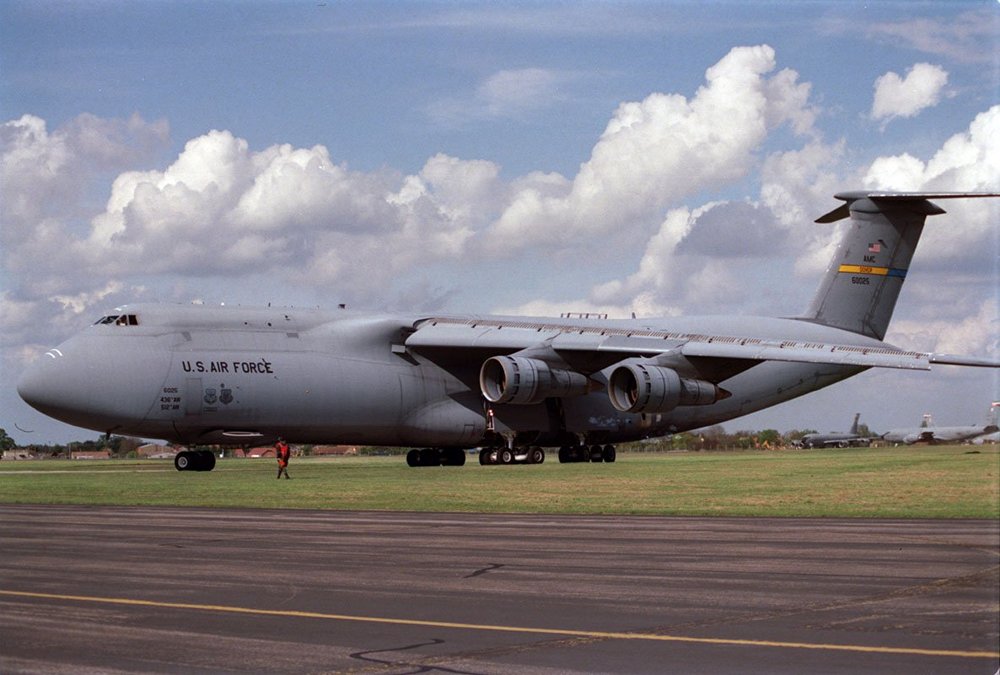
Transport aircraft C-5.
Source: all3dp.com
Another example of the use of 3D printing was demonstrated by marines from the state of Maryland. Using 3D-modeling and 3D-printing, they made a piece for an F-35 fighter, costing $ 70,000, spending only 9 cents. Sam Pratt, the mechanical engineer of the project office of the Additive Technology Factory in the city of Karderok, provided assistance to the marines.
Sam said that he was with a support platoon in South Korea and trained the CLB-31 marines to design 3D models and use 3D printing. His main task was to check the performance of 3D printers on ships. He also taught employees work in CAD Solidworks .

Sam Pratt tells the marines about 3D printing.
Source: all3dp.com
When a problem arose with the printing of the part necessary for repairing the F-35, a Marine officer offered to unite for cooperation. It turned out that the employees had already developed this detail, but could not find the right dimensions. The fact is that they used the amateur 3D-category printer and the free Blender 3D-editor - Blender is ideal for art projects, but it is difficult to create engineering products.
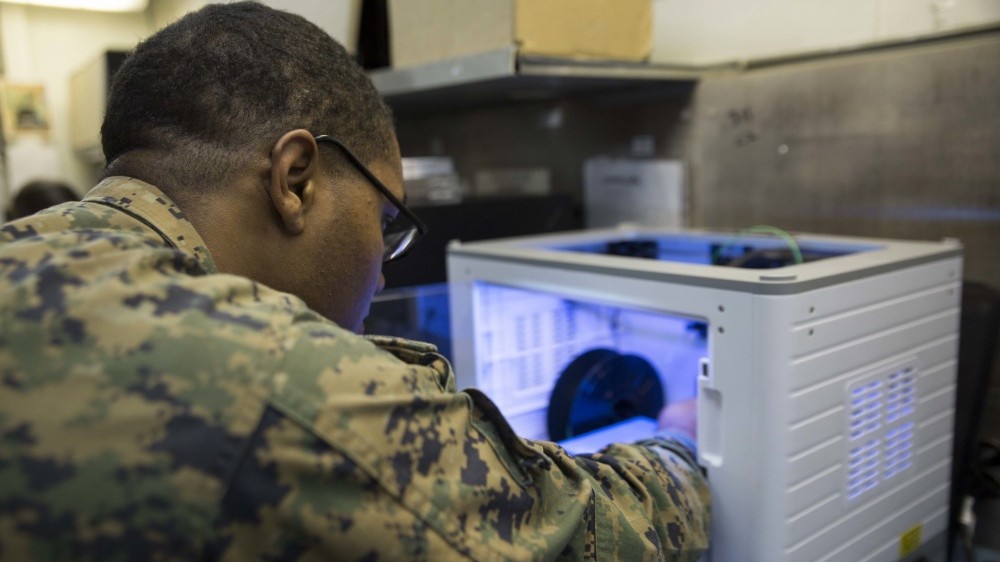
American marines for a 3D printer.
Source: all3dp.com
Pratt helped solve problems with modeling and printing, the part was printed from PET-G .
At the moment there are about 90 parts for ground equipment, which are approved for 3D printing in the army, you can download one of these parts and print it.
Major manufacturers are also not standing still and are mastering 3D printing technology. For example, Lockheed Martin, the aviation and defense industry giant, is actively investing in 3D printing.
Lockheed Martin uses 3D printing in production processes: there are already more than a hundred 3D printers in its arsenal for prototyping, tooling and printing finished products.
There are several reasons why Lockheed Martin uses 3D printing: a reduction in production time by up to 80%, a reduction in part weight by up to 40%, a proven reliability of parts under difficult conditions, and most importantly, the possibility of an additional increase in production in the near future.
For example, the manufacture of fuel tanks for spaceships according to traditional technologies takes from 18 to 20 months. Making such a tank using 3D printing takes two weeks. When this is achieved the best uniformity of the structure of the elements of the tank. Tanks are made using a Sciaky printer using EBAM (Electron Beam Direct Manufacturing) technology, in which a bar of a metallic material is heated by an electron beam.

Source: all3dp.com
Products, obtained by Lockheed Martin using 3D printing, have already passed the stage of laboratory tests and are actively used. Some of them travel through our solar system: in Juno's satellite, exploring Jupiter, eight 3D-printed brackets, and high-pressure printing valves are used on Orion spacecraft.
Fleet
In South Korea, loudspeaker grids for aircraft carriers are printed on 3D printers. Delivery of these grids from Europe took up to seven months and each cost $ 612. The printed part is manufactured in 4-5 hours and costs about $ 35. Printing parts reduces their cost and production time, and localization of production reduces dependence on foreign supplies, which can be delayed or become unavailable for various reasons.
General Electric signed a contract with the US Navy to develop software for fast 3D printing of spare parts for ships, aircraft and other important military facilities. The contract, worth $ 9 billion, is designed for four years and provides for the creation of technology "digital duplicates" - a complex of software, database of models and hardware. This technology will be used both for those spare parts that are no longer manufactured, and for new parts of ships and aircraft.
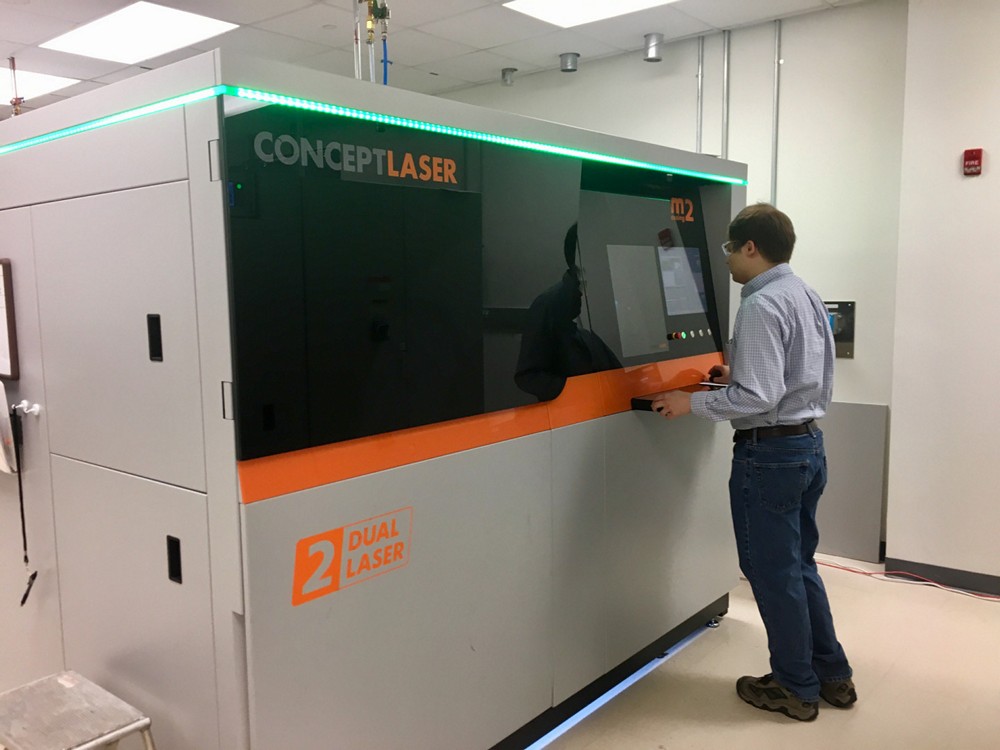
The development uses a 3D-printer ConceptLaser . Source: all3dp.com
The project is being implemented in two stages: at the first stage, software and hardware will be developed, at the second they will be combined into a complex capable of quickly creating the necessary products using the laser metal melting technology (DMLM).
Ammunition and small arms
The US Army designed and printed a fully functional grenade launcher called a “RAMBO” on a 3D printer. The development of a grenade launcher took about six months. He shoots grenades made also with the help of 3D printing.

RAMBO grenade launcher
Source: all3dp.com
The grenade launcher consists of 50 parts, all of which, with the exception of springs and hardware, are printed on a 3D printer.

Printed using 3D-printing parts grenade.
Source: all3dp.com
On tests RAMBO demonstrated characteristics similar to the grenade launcher M203, made in the traditional way.
The US Marines team is engaged in 3D printing and testing of small containers for explosives that can be used on the battlefield.

3D printed container for explosives.
Source: all3dp.com
The development of small arms began with the private sector - with the most primitive samples of pistols. On the Internet you can find drawings of products such as the acclaimed Liberator. The first 3D printed gun was printed on the Stratasys Dimension SST professional printer . The gun is designed for 9 mm ammunition and is charged during assembly.
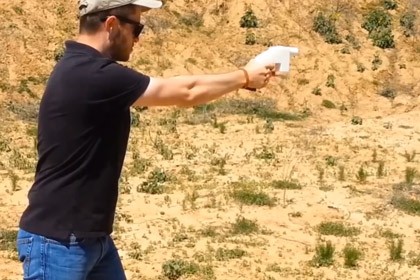
Test pistol Liberator.
Source: YouTube
The very possibility of obtaining weapons through 3D-printing so excited the public that the drawings of the “Liberator” were removed from open access, and in the USA they banned 3D-printed weapons.
Solid Concepts created a copy of the .45 Browning M4511 caliber pistol M4511 - Solid Concepts 1911 DMLS using the selective laser sintering method. The first sample withstood 50 shots, the later ones capable of making 600 shots without visible damage.
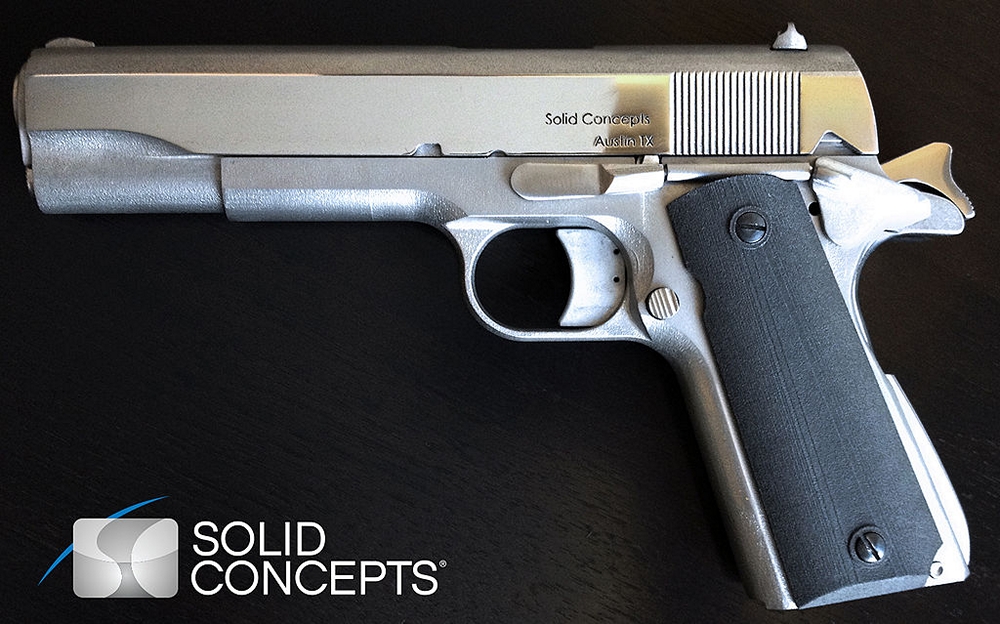
Solid Concepts 1911 DMLS.
Source: Solid Concepts Inc.
Recently, a ban on the proliferation of 3D printed weapons was lifted by a court decision. So, it is now possible to print weapons in the United States, with some restrictions: it can be no more than 50 mm in caliber and models cannot be freely available. This ban was easily circumvented by Defense Distributed, which posted models of its rifle for sale on one of the online services.

Source: depositphotos.com
“Our models are not in free distribution, as buyers pay money for them,” a company spokesman said.
Uniform and protection
In the Vatican, 3D printing technology was decided to be used for the production of traditional hats by the Swiss Guard.
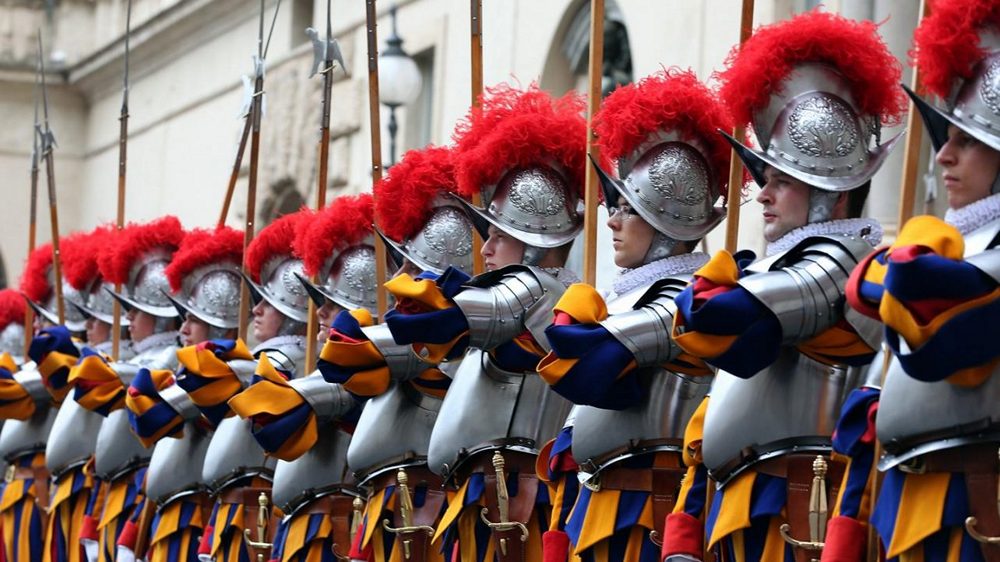
Swiss Guard.
Source: all3dp.com The
Swiss Guard is the personal guard of the Pope. For centuries, their form was made of metal, but now they have decided to keep up with the times. A 3D printed helmet will be significantly cheaper and, more importantly, lighter.

A prototype of a helmet printed on a 3D printer.
Source: all3dp.com
Helmets are made of PVC, they bear the coat of arms of Pope Julius II, who founded the Swiss Guard in 1506.
The US military turned to the creators of the “Iron Man” costume, a movie character, for help in creating uniforms for the soldier of the future. The military commissioned Legacy Effects studios to develop and print component prototypes for the TALOS special outfit kit.
TALOS will contain a cooling system to maintain a comfortable temperature in a suit, a tactical display and a built-in exoskeleton.
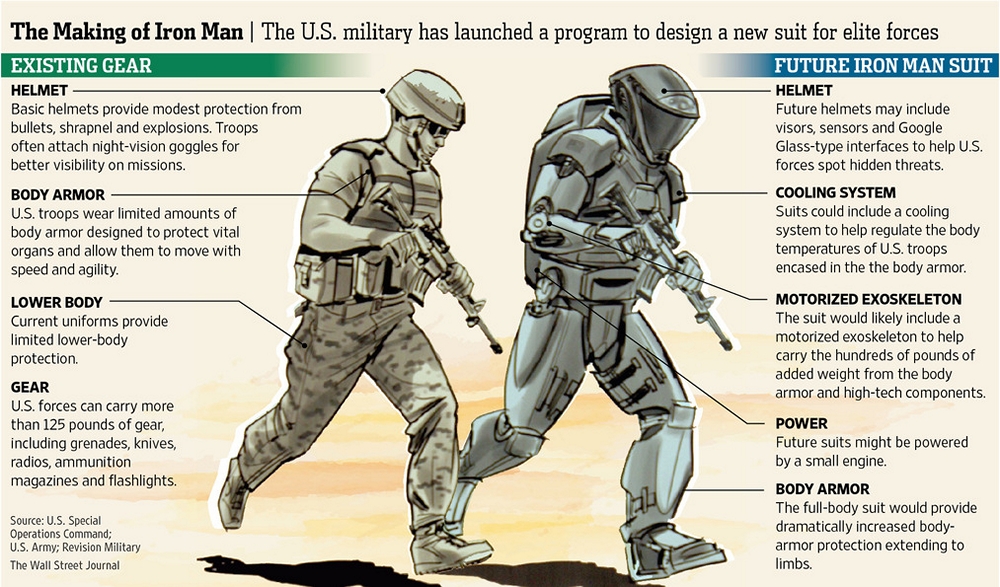
Future uniform concept.
Source: 3dprintingindustry.com
The studio team will join a large team already working on a project that includes bioengineers, combat veterans and technologists.
Building
The US Army Engineering Research Team printed a large building in just 21 hours. The building area is 47.5 square meters. The hut-type building is the result of a three-year US Army program “Army Construction Engineering Research” (ACES), with a laboratory in Champagne, Illinois.

Barracks printed on a 3D printer.
Source: all3dp.com
Such a short time spent on the construction of the building means that such temporary buildings will be more accessible with the development of 3D printing. These buildings can be used as shelter for refugees or temporary shelter in case of natural disasters.

The process of building a 3D printer.
Source: all3dp.com
The building looks like an ordinary house, but in the future such structures can be given any appearance. Such buildings are also more energy efficient than traditional ones - they require less energy for heating and cooling.
ACES reduces the amount of building materials used by half and allows you to print using local materials. The reduction in labor demand is 62%, compared with the construction of plywood structures.

Laying the concrete mix construction 3D-printer.
Source: all3dp.com
Self sufficiency
Collaboration between the US Army Research Laboratory and the Marine Corps led to the development of technology for producing PET filament, for printing on a 3D printer, from plastic waste, such as bottles from under water.
According to the army, water bottles and plastic packaging are the most common trash on the battlefield. Both American and allied forces produce a large amount of this waste, the possibility of processing them will reduce the cost of transporting raw materials. The filament obtained from recycled materials, provided that they are properly cleaned and dried, is completely equivalent in tensile strength to the analog from primary raw materials.
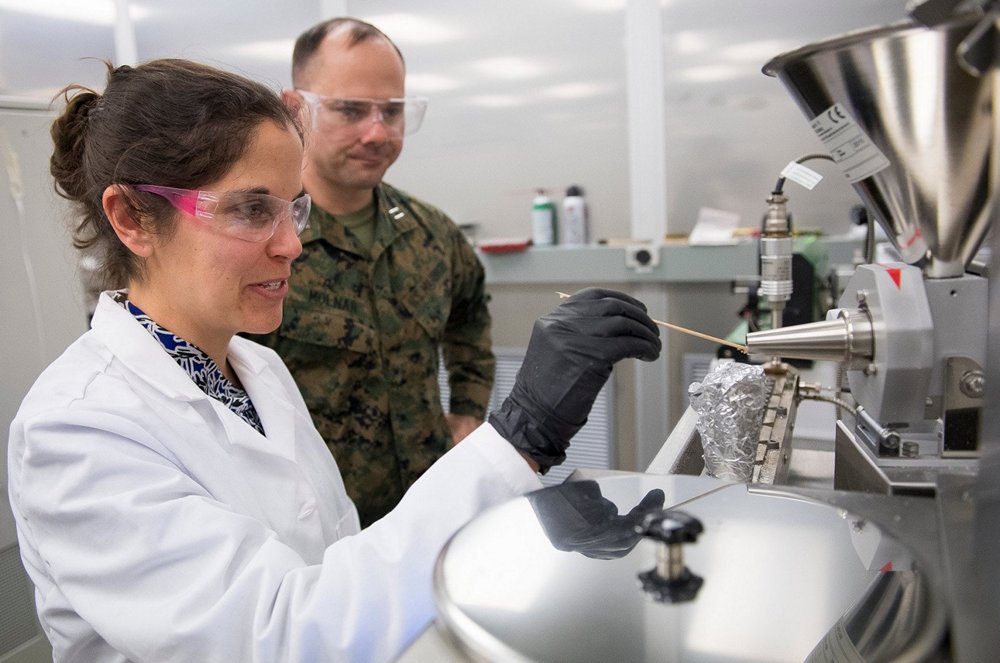
Source: all3dp.com The
development of an installation located in a standard shipping container that will allow production of filament from waste is underway.
Also, the US Army is developing food printers. Their advantages are obvious: the possibility of reducing the cost of food, compared with the traditional delivery of rations from abroad; the possibility of drawing up an individual menu, in accordance with the preferences of each soldier; the possibility of individual balancing the diet, depending on the dietary needs of each soldier.
The printer, like the classic 3D printers, lays the components in layers.
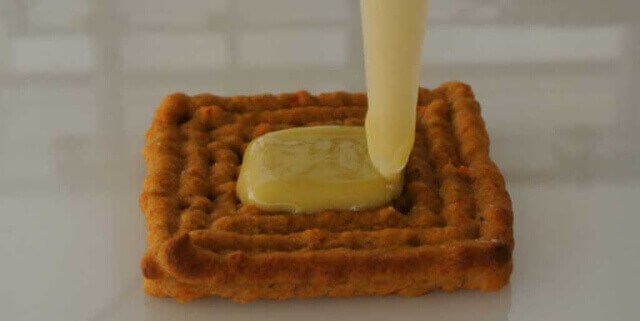
Food printed on a 3D printer.
Source: all3dp.com The
printer uses an ultrasonic agglomeration method for 3D printing of small snacks.
Electronics
Researchers at the University of Massachusetts Lowell have developed a new method for 3D printing of conductive components for radar systems. They created a new type of ink that allows you to make radars using 3D printing.
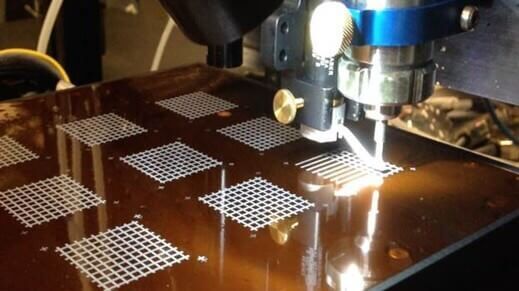
Electronic components produced by 3D printing.
Source: all3dp.com
Raytheon, one of the defense industry companies, sponsored the development.
According to the developers: “The use of this technology allows us to obtain cheaper and more universal systems than those obtained by classical methods. This technology has obvious advantages in the military sphere, but can also be used in civilian industry, for example, in the production of meteorological stations or unmanned vehicles. The main problem was obtaining ink with desired properties capable of working with high-frequency radiation. ”

Putting ink on a plastic plate.
Source: all3dp.com
Two heads with different principle of operation are installed on a 3D printer. One puts ink by the method of aerosol spraying, the second fixes them with the method of microvibration. Using this technology, such components of radar systems as voltage-controlled capacitor (varicap), phase shifter (for electronic control of phase-array radar systems) and frequency filters can be manufactured.
The ink material is based on nanoparticles that can be injected into the molten plastic and then solidified with it, creating conductive structures.
The US Air Force Research Laboratory has teamed up with American Semiconductor to create a silicon-polymer memory chip.
Thanks to 3D printing technology, they were able to develop a new, ultra-flexible chip with integrated sensors.
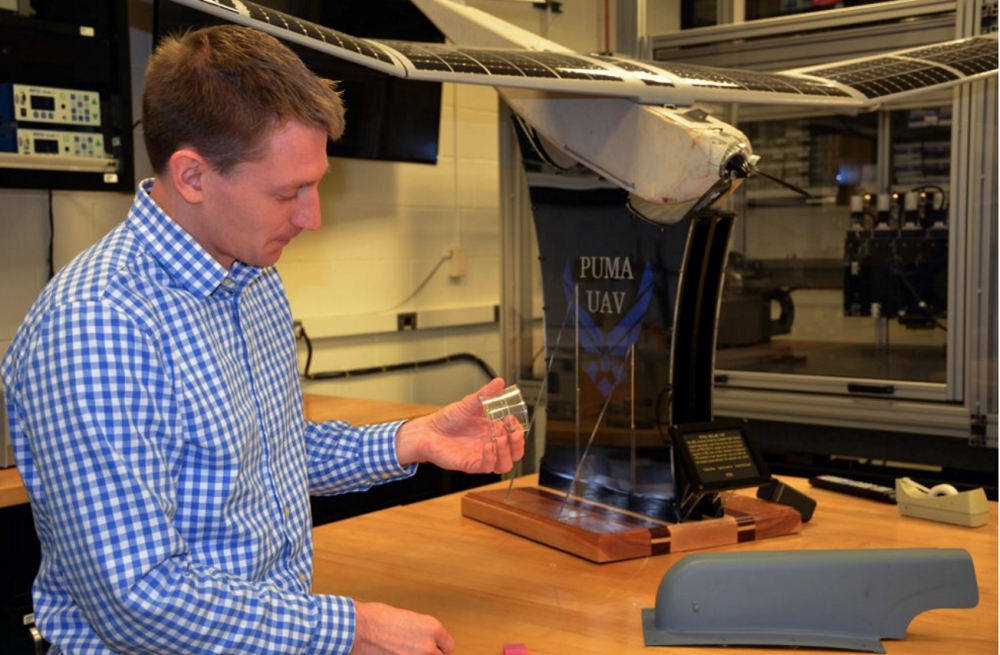
Dan Berrigan holds a new flexible chip.
Source: all3dp.com
According to American Semiconductor, the silicon wafer is 2000 angstroms thick. This tiny chip can measure humidity, temperature, muscle fatigue, and so on. This makes it ideal for use in new technologies to control the well-being of wounded soldiers or the elderly.
Not only research laboratories, but also industrial giants are engaged in the production of flexible electronics.
Apple, Boeing and the Massachusetts Institute of Technology have created an alliance to collaborate with the US Department of Defense in the field of flexible electronics. The alliance’s goal is to deliver high-quality, flexible electronics by 2020.
The Department of Defense plans to allocate $ 75 million over 5 years to a consortium called the FlexTech Alliance and raise $ 96 million in additional funding.
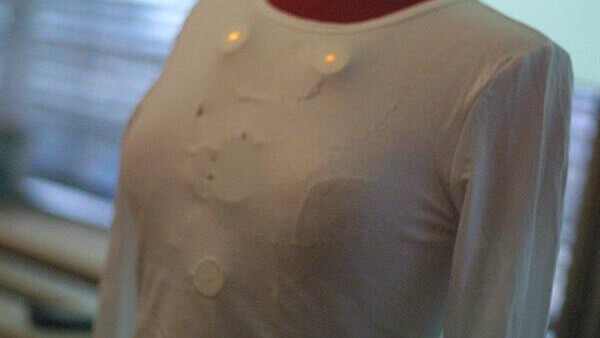
"Smart" clothes.
Source: all3dp.com
The consortium includes 96 companies, 11 specialized laboratories, 42 universities and 14 state and regional organizations. The key partners of the consortium are Apple, Boeing, General Electric, General Motors, Lockheed Martin, Motorola Mobility, Qualcomm and many others. Partner universities include Cornell, Harvard, Stanford, New York University and the Massachusetts Institute of Technology.
Practical application will be, first of all, focused on military purposes, such as uniforms with vital signs monitoring sensors. Pressure sensors can also be installed on vehicles to monitor deformation in key areas.
Civilian application of such microcircuits will help athletes control body performance and improve results, and people with cardiovascular diseases can control and prevent seizures. This technology will allow hospitals to massively monitor their patients.
Concepts
British scientists and engineers are working on the cultivation of military UAVs using chemical technology.

Hydroponic Chemical.
Source: all3dp.com
Military developers explore all possible and impossible technologies. In this case, they are working on a chemical device. “Chemputer” is a registered trademark of BAE Systems. The technology is developed by Professor Lee Cronin (Lee Cronin) from the University of Glasgow, it is a 3D-printing of UAVs and biomaterial aircraft.
Unlike classic 3D printers, the chemical chemical conducts chemical reactions at the molecular level, creating all the elements - from electronics to wings.
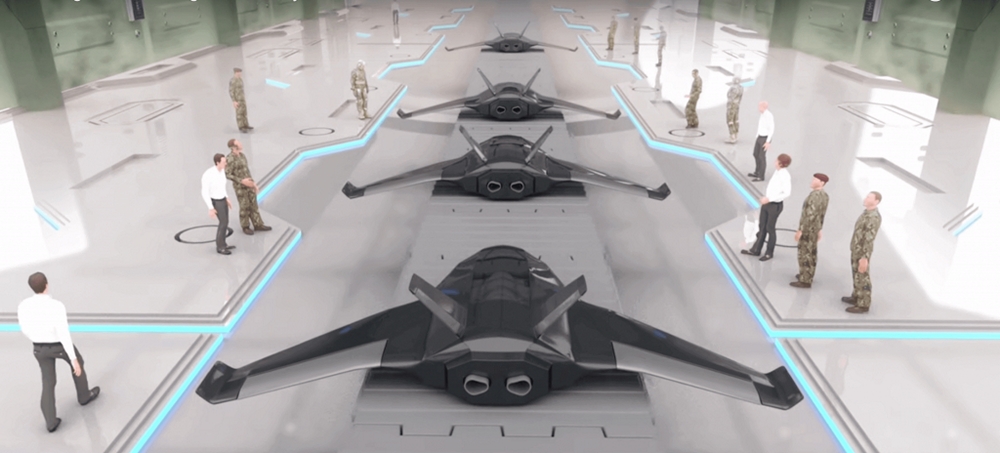
Prototypes drone.
Source: all3dp.com
While British scientists are inventing new printing technologies for the military, simple makers create the weapons of the future with the help of ordinary 3D printers.
So, David Wirth created a hand railgun in his workshop.

David Wirth with his railgun.
Source: all3dp.com
Perhaps inspired by the Quake computer game, he created this weapon using a CAD, 3D printer and Arduino platform. Railgun can use as an ammunition aluminum or graphite bullets, firing them at a speed of 250 m / s. The design is based on six huge capacitors, which, with a total weight of about nine kilograms, store more than 1,800 joules of energy for each shot. Also the railgun consists of batteries, two parallel contact rails and a pneumatic ammunition supply system.

Railgun scheme.
Source: all3dp.com
Tests have shown that the railgun is inferior to a conventional pistol in terms of shot energy, but can penetrate a centimeter sheet of plywood. For comparison: the stationary military railgun accelerates the projectile to a speed of 13,000 miles per hour in 0.2 seconds, the speed of the projectile from the Wirth apparatus - 560 miles per hour.
Conclusion
The technology of 3D printing is increasingly being used in the army. The main role in its promotion is the need to reduce costs. 3D printing of parts on the spot helps to solve logistics and security problems, saving time and money on delivery, which is important for the army and aviation, and even more so for the fleet - it is impossible to plan on the shore and take with you everything you need, and delivery on board at sea is expensive.
We cited as examples only a small part of cases on the stated topic - it is impossible to describe in one article all the prospects for the use of 3D printing in the military industry. And the majority of decisions applied by the military in production are also relevant for the civil sector.
Buy a 3D printer for productionYou can in Top 3D Shop - our experts will help you choose the best equipment for solving any tasks.
Want more interesting news from the world of 3D technology?
Subscribe to us in the social. networks:




